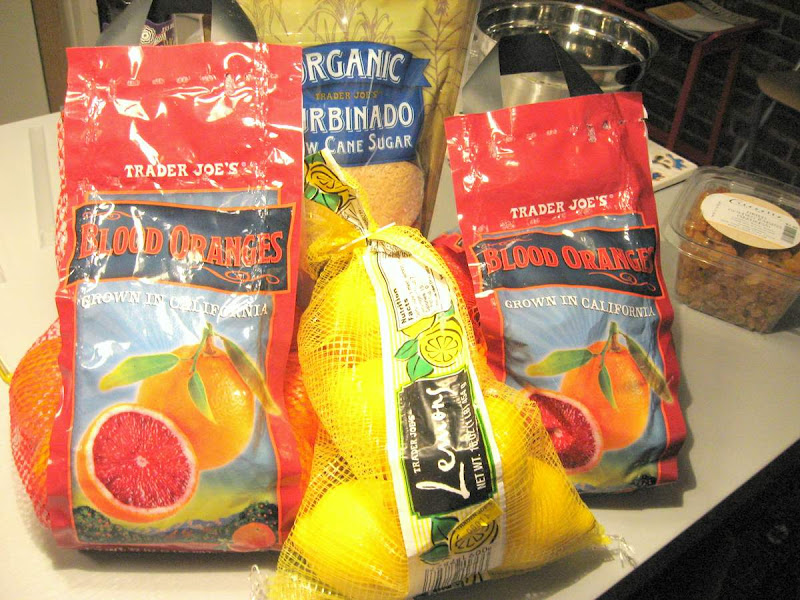A Leetle Background
I do not like a sweet, bouncy jam. I tried making jam with pectin once, and it just annoyed me. My ideal marmalade is slightly runny and tart with a very pronounced orange flavor and lots of rind for texture. In fact, my ideal marmalade comes from someplace in the Loire valley, where it was likely made following a centuries-old family recipe, jarred without any adherence to FDA standards, and sold as an afterthought at a michelin-starred restaurant/auberge. Someplace like this:
 |
| Auberge de Launay *Come to think of it, this may actually be the origin of the mysterious marmalade... |
But since I currently don't have the several thousand dollars necessary to fly to France, nor do I accurately remember the address of this house of marmalade* that my mother and I wandered into in the early-aughts (before I even owned a digital camera), I was on my own.
 |
| A little runny is okay by me |
Equipment was not too much of a problem. Thanks to Mr. Quail we already had a very large pot for sterilizing the jars. I bought ball jars (8oz, tall and thin), lids, a jar grabber (which, yes, I used incorrectly the first time, managing to spill boiling water all over myself on me first try. Use the side that curves to grab the jar, kids.), and read up on how to sterilize. A note on sterilization--once I figured out how to use the jar grabber (okay, when Mr. Quail figured it out), the sterilization process was actually very easy. The biggest challenge was finding enough counterspace next to the stove to fill the jars. Instructions abound on the interwebs--and they're all practically the same.
Jam Science
Now comes the part that led me to nearly 18 hours of research: the recipe. Because I didn't want a sweet jam, I wanted to use less than the 1 to 1 ratio of sugar to fruit that is normally recommended. But every time I looked for a recipe, warnings abounded: Do not use less than the recommended amount of sugar! Do not change the recipe! It could kill you!
Really? Using less than 1 cup of sugar PER 1 cup of fruit could kill me? Is sugar that necessary to prevent botulism/spoilage? Can't you basically can anything--including fruit--without sugar? So then I started looking up botulism and entered a world of home canning websites I never thought existed (between home canning and home brewing, the Quails have apparently gone hipster), not to mention reading through the USDA's guidelines on home canning. Long story short: sugar doesn't aid in preserving--at least not before you open the jar. It helps in setting up the jam (not a problem for me, since I didn't care) and in preserving the jam once opened. Botulism is mainly affected (in home canning) by ph, but with high acidic fruits--like oranges--ph isn't a problem. (I suppose I should warn that before you go on a home canning spree and start canning everything from frozen grapes to leftover meatloaf, you should do research to make sure what you're canning meets safety standards). So, finally, armed with Canning for a New Generation, which includes all sorts of low-sugar/no-pectin recipes, I felt ready to jar, er, can.
Onto the Marmalade
 |
| My ingredients |
First I boiled the oranges, as recommended, to make it easier to scoop out the insides.
The flesh (ewwww!) went into two jelly bags.
The peels I cut into strips. Some say to remove the pith. I didn't--and frankly, I think it turned out fine. I was also a little lazy about making even slices, but hey, the skins were really hot at that point.
Then everything went into the pot with 7 cups of water and 3-4 cups of sugar (definitely less than the amount of fruit being used). Part of the way through, I squeezed the remainder of the juice and pectin from the jelly bags into the liquid and disposed of the remains, brought it up to a simmer, and let cook until it reached 220 degrees on my candy thermometer (which I've had for years, but had never used until now). 220 degrees is the point where jam sets. Again, I didn't particularly care, but I figured it couldn't hurt.
Once it reached setting point, I added cognac and orange liqueur to taste. Actually, I probably added a bit too much. It's a boozy jam.
Finally, I filled the jars, sterilized them in a water bath (using an improvised stand made out of tin foil. Thank you, apartment therapy), and let them sit overnight. I was, admittedly, rather excited when I heard the jars "pop"--proof that they were airtight and shelf stable (for up to a year, mind you. This boozy marmalade will not survive Cormac McCarthyism).
Real-world Marmalade Applications
Blood-orange cognac marmalade sandwich on homemade cheddar jalepeno biscuit with crazy-good (not homemade) bacon
Marmalade on stone cut oatmeal with almond milk, pecans, and dried sour cherries.
Finally, the KITCHEN CARNAGE (thanks Mr. Quail for helping me clean this up. I think I'll wait a few months before home canning anything else)









No comments:
Post a Comment